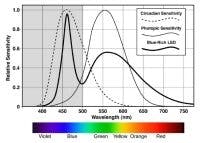The rapidly expanding use of bluish-white outdoor lighting threatens visibility at night and jeopardizes the nocturnal environment worldwide, according to a statement from the International Dark-Sky Association (IDA).
The statement says that developers of light sources should be required to refine their products to limit blue light at wavelengths shorter than 500 nm. The IDA also discourages the use of bluish-white lamp sources with a correlated color temperature above 3000 Kelvin.
The IDA is a US-based not-for-profit organization aiming to preserve and protect the night-time environment through environmentally-responsible outdoor lighting.
The advisory notes that the “laudable” demand for energy-efficient lighting has resulted in a new generation of electric light sources such as LEDs and induction lamps that emit a cold, bluish white light. Although LED lighting is mentioned specifically, this issue was discussed in an LEDs Magazineinterview with Peter Strasser, IDA managing director, who clarified that the IDA is not taking an adverse position towards any specific technology.
IDA states that the bluish light can have significant environmental impact, causing light pollution and sky glow, as well as glare and the compromising of human vision in the aging eye. “In addition, blue light has a greater tendency to affect living organisms through disruption of their biological processes that rely upon natural cycles of daylight and darkness, such as the circadian rhythm.”
IDA says that “Some manufacturers and government agencies are misrepresenting the visual effectiveness of these bluish-white light sources, and the environmental impacts are not being considered.” Because of this, the IDA is encouraging government and other concerned parties to support additional scientific research on this subject. “Research will help to understand fully the impact of bluish white light and guide the evolution of lighting technology to protect human health and the nocturnal environment while providing safe and efficient outdoor lighting.”
Strasser told LEDs Magazine that the IDA is continuing its research. “A white paper is currently being distributed for review by a panel of experts. We hope to have it available within 2 weeks,” he said.
At the recent Light Canada, held in Toronto, Peter Strasser and I were discussing LED outdoor installations. The point arose that because of the greater efficacy achieved with higher color temperatures, it appears that utilities such as PG&E are promoting the 6000K color temperature. I recently spoke with Mary Matteson Bryan, who manages the Emerging Technologies program for PG&E. She reassured me that PG&E is not promoting 6000K lighting, and that the decision is solely up to the customer who owns the lighting stock. This was reassuring news for Strasser.
This will surely be a “white-hot” topic at the upcoming IDA Annual General Meeting and Conference to be held November 14-15 at the Wyndham Phoenix Hotel in Phoenix, AZ.
The US DOE webcast “Hitting the Target: ENERGY STAR SSL Outdoor Area Lighting” takes place today at 1:00 pm Eastern, 10:00 am Pacific. LEDs Magazine will be there to see if this is a topic of discussion amongst the participants.
LEDs Magazine will bring you further news on the topic when the IDA White Paper is released, in an interview with Peter Strasser, as well as from the IDA Conference. LEDs Magazine will also be bringing you more background from PG&E in light of their new rate structure and other PG&E program activity.






